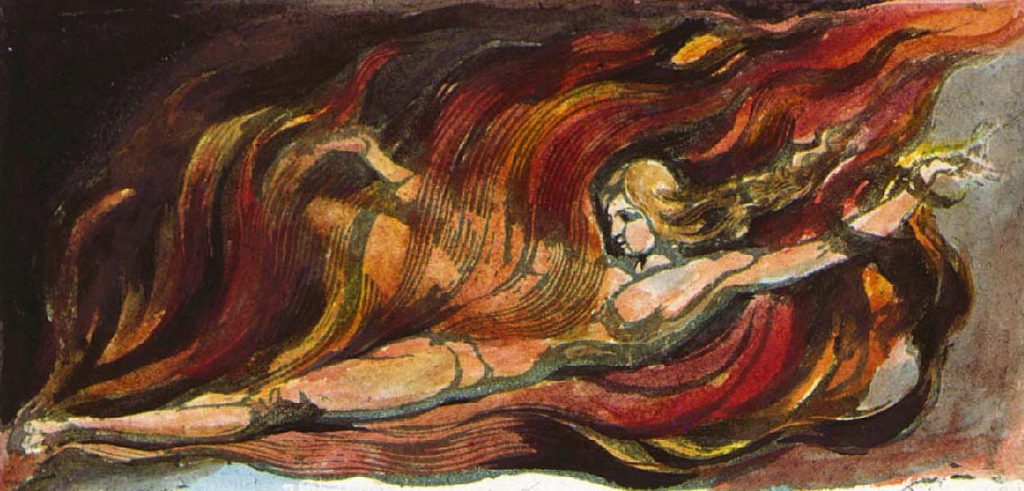The exhibition William Blake and the Age of Aquarius will open at the Block Museum of Art at Northwestern University in a few months. I recently had the chance to ask some questions of Corinne Granof, the museum’s curator of academic programs. The conversation has been edited very slightly.

Blake, The Marriage of Heaven and Hell copy D (1795), pl. 3. Library of Congress, Rosenwald Collection. Image courtesy of the Blake Archive.
Can you reveal the focus of your exhibition? Where did the idea come from?
William Blake and the Age of Aquarius will explore the impact of Blake on a broad range of American artists and will be the first exhibition to consider how Blake’s art and ideas were absorbed and filtered through American visual artists from the end of World War II through the 1960s. Blake became for many a model of non-conformity and self-expression, and was seen as an artist who engaged in social and political resistance in his time. The exhibition will consider parallels between Blake’s time and mid-twentieth-century America, touching on such issues as political repression, social transformation, and struggles for civil rights. Blake’s protests against the conventions of his day were inspirational for many young Americans disillusioned by perceived cultural tendencies of social uniformity, materialism, and consumerism, racial and gender discrimination, and environmental degradation. This generation sought in Blake a model of independence, imagination, and resistance to authority. The exhibition will feature American artists for whom Blake was an important inspiration and will include more than 150 paintings, prints, drawings, photographs, films, and posters, as well as original Blake prints and illuminated books from collections throughout the United States.
The exhibition is curated by Professor Stephen Eisenman, Department of Art History, Northwestern University, in collaboration with the Block Museum. The idea for the exhibition came out of Professor Eisenman’s research and interest in Blake revivals in the nineteenth and twentieth centuries and was shaped by Block Museum’s Ellen Philips Katz Director, Lisa Corrin, who helped focus the exhibition on the 1960s.
When will it be?
It is opening later this year, the fiftieth anniversary of the Summer of Love, September 23, 2017–March 11, 2018.
What space at the museum is being used?
The exhibition will be installed in the museum’s main gallery, and will begin with a small Blake exhibition that helps lay out the themes that are explored and amplified by American artists from the 1940s through the 1960s. The ideas of the show will be extended in an exhibition catalogue of the same name that is forthcoming from Princeton University Press.
I know from the journal’s annual sales reviews by Bob Essick that Northwestern’s special collections library often makes Blake purchases (such as the 1839 Pickering edition of Songs in 2016 or the two plates of “Night” from Songs copy W in 2015). Will the Blake items on display be from Northwestern’s collection, or are there also works from elsewhere?
Yes, the Block Museum of Art regularly collaborates with Northwestern University Libraries. The exhibition will include a significant number of Blake works from the Charles Deering McCormick Library of Special Collections at Northwestern University Libraries, along with loans from the Yale Center for British Art and the Rosenbach Museum and Library.
Will there be other activities associated with the exhibition (on the lines of concerts/talks)?
We are currently planning engagement programs that will take place in connection with the exhibition, including lectures, music programs, workshops, and poetry-based events. William Blake used the democratic medium of printmaking to weave text and image, imagination and political commentary. Some public programs will look at the resonance between Blake’s process and printmaking from the 1960s through today, with a focus on how activism manifests in text and image. Others will explore the ways in which Blake’s independence, imagination, and resistance to authority relate to struggles for civil rights in the 1960s and today.
Many thanks to Corinne for taking the time to respond. For updates on the exhibition, keep an eye on @NuBlockMuseum on Twitter.
